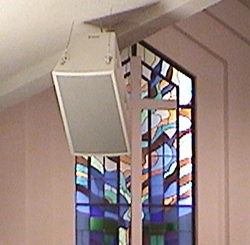
Q: I’m on a committee to purchase a new sound system for my church. Are there any special considerations that go into this type of installation?
A: In many ways, designing an effective system for a house of worship is one of the most demanding jobs in the audio business.
While you are undoubtedly interested in good stewardship of your congregation’s funds, keep in mind that the following points are not “luxuries,” but are essentials for good sound system.
#1 Dynamic Range: Church sanctuaries are usually quieter than other gathering places. In fact, the noise floor sometimes resembles recording studio environments more than auditoriums.
So, the sound system must be quieter than usual to prevent audible noise in the audience area. You should specify a system with as much as 96dB of dynamic range.
#2 Signal-to-Noise Ratio: Many listening environments have a “sweet spot” for which the sound system performance is optimized. But in a house of worship, every seat must be optimized for adequate signal-to-noise ratio. Generally a minimum of 25dB S/N ratio is appropriate for every seat in the audience area.
#3 Uniform Coverage: Many auditoriums are plagued with “hot” and “cold” spots in sound coverage. This can usually be attributed to interaction between multiple loudspeakers, and is unavoidable when more than one loudspeaker is used to provide sound coverage. A good design assures that there is even coverage in the audience area, and that no seats are unusable because of loudspeaker interaction.
#4 Versatility: While it is possible to design sound systems that are optimized for speech or music, your system must perform well for speech and music. The attributes of these two types of systems are often at odds, so this is a very difficult task.
Your system must have the accuracy and clarity needed for speech reproduction, while maintaining the extended frequency response and power handling required for music.
#5 Hum and Buzz: Audible AC hum is a major detriment to a church sound system. It usually results from improper grounding practices, either in the wiring or the actual equipment. Remember that off-the-shelf equipment must often be modified to work without hum.
#6 Gain Before Feedback: Whenever a microphone is placed in the same room as a loudspeaker, the potential for feedback exists.
Things that aggravate this further are multiple microphones and long miking distances – necessities for most churches. Your sound system must be extremely stable, meaning that loudspeaker array design and mic placement are critical to the end result.
Your sound personnel must understand the limitations of the sound system and be trained to manage the open microphones and working distances for people using the system.
#7 Wireless Microphones and RFI: These can adversely affect the performance of a sound system. It must be properly shielded against such, with appropriate filtering devices installed when necessary.
In addition, the operating frequencies for your wireless mics must be carefully selected to work properly in the presence of other RF broadcasts in your area.
#8 “Clean” Installation: An important yet often overlooked aspect of sound system design is the installation. Proper interconnect practices must be carried out, and all applicable electrical codes must be observed.
In addition, a “clean” installation means that wiring has been concealed as much as possible, and that the finished system blends well with the decor of the building.
#9 Professional Equipment: Selecting marginal equipment is usually false economy. You need a system that provides reliable, quality performance for years to come.
It’s best to deal only with companies that provide reliable, repairable products. Loudspeakers should be “stress tested” for safety, so they can be suspended above a congregation with confidence.
#10 Calibration, Training and Documentation: A properly calibrated sound system will be much easier for your personnel to operate. A significant amount of expertise is required to make a system “user friendly.”
Your sanctuary is a critical listening environment for speech and music. Your sound system must provide adequate gain, intelligible speech, even coverage and extended bandwidth to all listener seats. The best value in a sound system is one that meets all of these criteria.
For more tech tips go to Sweetwater.com















